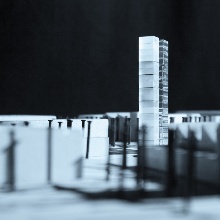As part of the Collaborative Research Center SFB 1244 “Adaptive skins and structures for the built environment of tomorrow”, initiated by Professor Werner Sobek, the world's first adaptive high-rise building is being constructed at the University of Stuttgart. The spectacular large-scale test building, which is funded by the German Research Foundation (DFG), will now become part of the International Architecture Exhibition 2027 (IBA’27) in Stuttgart. This was announced by the IBA supervisory board at a press conference in Stuttgart on 28 July 2020.
The decision makes the innovative lightweight building of the University of Stuttgart one of the first of 13 projects in the Stuttgart region that has been considered by the IBA, the board of trustees, and the supervisory board as having great potential for joint further development with a view to the exhibition year 2027. The 36.5-meter test building, which is currently under construction, is located on the Vaihingen campus of the University of Stuttgart and is the first structure in the world that can react actively to external influences such as wind or earthquakes in a targeted manner and in real time. An artificial musculature (the so-called actuator system) counteracts short-term loads, for example from gusts of wind, thus preventing the building from vibrating. By means of targeted temporary deformation of the supporting structure at some few points, the actuators also prevent critical components from being overly strained by loads that are acting on them for longer periods of time (e.g. snow or similar).
50 percent of mass and 46 percent of greenhouse gas emissions are saved
Behind this research is the goal of achieving a radical reduction in weight and thus in the amount of resources used - one of the great social and scientific challenges of our time. With their adaptive high-rise building, the researchers at the University of Stuttgart are saving almost 50 percent of the mass that a comparable building of conventional construction would have. At the same time, there are 46 percent less greenhouse gas emissions.
The Collaborative Research Center SFB 1244, funded by the German Research Foundation (DFG), is concerned with the question of how, in view of a growing world population and shrinking resources, more living space can be created in the future with less material in a climate-neutral way. Against the background of achieving maximum reduction in material and energy consumption, while at the same time increasing user comfort, 14 university institutes from a wide range of disciplines are researching the potential and applicability of adaptive building shells and structures in the construction industry.
Prof. Werner Sobek from the Institute of Lightweight Structures and Conceptual Design (ILEK) at the University of Stuttgart is the spokesperson of the Collaborative Research Center. He and the deputy speaker of the SFB, Prof. Oliver Sawodny from the Institute for System Dynamics (ISYS), are very satisfied with what has been achieved so far: “The research of SFB 1244 impressively shows how we can build with a radically reduced use of resources. Ultra-lightweight construction is a key technology for the construction industry in the 21st century.”
The total construction costs of the project, which is partly funded by the state of Baden-Wuerttemberg, amount to EUR 2 million. The University of Stuttgart is contributing approximately EUR 1.3 million. From spring 2021, there will be regular public tours of the high-rise demonstrator building. The tours will also provide insights into the functioning principles of adaptive construction and into other work of the interdisciplinary research team in SFB 1244.
Expert Contact:
Specialist contact:
Manuela Brüggeboes, University of Stuttgart, Institute of Lightweight Structures and Conceptual Design, phone: 0711 685 66223 or 66227, email
Press contact:
Roberta Toscano, University of Stuttgart, Institute of Lightweight Structures and Conceptual Design, phone: 0711 685 66548, email


